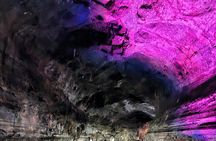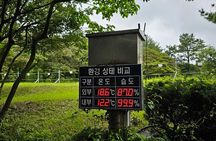
No expiration date
Easy refund
Free exchange
Easy booking
Jeju Day Tour - World Heritage & UNESCO
$320
This is an experience gift voucher. The recipient will book the experience after
they redeem the gift voucher.
Overview
This tour's itinerary varies depending on the departure point. The departure points are Seogwipo City and Jeju City.
World Natural Heritage and UNESCO Day Tour from Seogwipo City in the beautiful South of Jeju.
Oedolgae and cool waterfall tour with the sound of birds and waves in nature. and Walking and looking at Manjanggul Cave, a World Natural Heritage Site, and Seongsan Ilchulbong Peak, a UNESCO site, are awe-inspiring.
When departing from Seogwipo, Go to the Seongsan Ilchulbong, Oedolgae, Jeongbang Waterfall, jusanjeoli cliff and Choose One (Manjanggul Cave or Osulloc.)
When departing from Jeju city , Go to the Hamdeok Beach, Manjanggul Cave, Woljeongri Beach, Seongsan Ilchulbong, and Choose One (Seopjikoji or Seongeup Folk Village )
World Natural Heritage and UNESCO Day Tour from Seogwipo City in the beautiful South of Jeju.
Oedolgae and cool waterfall tour with the sound of birds and waves in nature. and Walking and looking at Manjanggul Cave, a World Natural Heritage Site, and Seongsan Ilchulbong Peak, a UNESCO site, are awe-inspiring.
When departing from Seogwipo, Go to the Seongsan Ilchulbong, Oedolgae, Jeongbang Waterfall, jusanjeoli cliff and Choose One (Manjanggul Cave or Osulloc.)
When departing from Jeju city , Go to the Hamdeok Beach, Manjanggul Cave, Woljeongri Beach, Seongsan Ilchulbong, and Choose One (Seopjikoji or Seongeup Folk Village )
—
The experience offers several options. This price includes:
Regular taxi
Regular Taxi
Pickup included
Regular Taxi
Pickup included
Tour guide
Language: English
Human tour guide
The experience offers several options, check yours above
- we offer pick-up and drop-off services from Jeju island
- Regular Taxi / Jumbo Taxi / Minivan /Mini-bus , The fuel and parking fees are included in the price
- Insurance included
- Speaking simple English or japanese or chinese Driver
- Jeongbang Waterfall / jusangjeli /Sungsan ilchulbong /Manjanggul cave/
- Lunch / Personal Expenses / Food and Drinks
-
OedolgaeWhen departing from Seogwipo-si 외돌개 (Oedolgae) Oedolgae, the starting point of Jeju Olle Trail Course 7, is a stone pillar that rises 20m high from the sea. Standing alone on the sea, it was named ‘Oedolgae’. It is also called ‘General Stone’ and ‘Grandma Rock’, and there is a story that General Choi Yeong decorated this rock like a general when fighting against the Yuan Dynasty and made the enemy self-destruct. For the origin of the name 'Grandma Rock', read the legend below. Not only the visible rocks, but also the life of Jeju people waiting for the people of the sea can be seen. These stone pillars are believed to have been created during a volcanic eruption. A chimney-shaped stone pillar in which the surrounding rocks are eroded by waves and only such strong rocks remain is called a sea stack in scientific terms. Pine trees grow naturally on the top of Oedolgae, giving a picturesque impression.
- 천지연폭포(Cheonjiyeon Falls) At Cheonjiyeon Falls, white water falls from the rock cliff and make a thundering sound. It gets its name because it means “sky connected with land.” It is 22m high and 12m wide, and the view and the sound that the waters create when they fall is magnificent.Not only Elaeocarpus, which is designated as Natural Monument 163, but also a variety of temperate plants such as brambles, Psilotum nudum (L.) Griseb., Siebold's chinquapin, Shiny xylosma, and camellias grow in the valley near Cheonjiyeon Falls. It is also famous for the Natural Habitat for Giant Mottled Eels (Natural Monument 27), which are nocturnal. (pass by)
-
Jeongbang WaterfallWhen departing from Seogwipo-si 정방폭포 (Jeongbang Falls) Jeongbang Falls is one of the Jejudo Island’s top 3 falls, along with Cheonjiyeon Falls and Cheonjeyeon Falls. It is the only fall in Korea where water falls directly into the sea. The fall is 23m high and the two streams of waterfall that fall down the black cliff create a thrilling sound and a wonderful view. Moreover, the steep cliffs and old pine trees around the fall create a picturesque view, and this view was chosen as one of Ten Scenic Sights of Yeongju with the name of “Jeongbanghapok.” It is said that the words ‘Seobulgwacha’ are engraved on the cliffs of Jeongbang Falls.According to legends, a man named Seobul came to the island in search of an elixir plant on the orders of China’s Qin Shu Huangdi a long time ago. Unable to find the elixir plant, he headed west to return to China, and became captivated by the site of Jeongbang Falls, leading to him writing “Seobulgwacha’ on the cliff.
-
Seongsan Ilchulbong성산일출봉(seongsan illchulbong) Seongsan Ilchulbong Tuff Cone, a landmark attraction of Jeju, was formed about 5,000 years ago from an eruption of magma on the ocean floor. It is especially famous as a sunrise viewing spot, known to be one of the top ten exquisite sceneries of Jeju Island.Besides viewing the sunrise, Seongsan Ilchulbong Tuff Cone is also known to be an excellent trekking spot. The Seongsan-Ojo Trail connects two villages by crossing the peak. Another popular trail, the Jijil Trail, offers a closer look at the UNESCO-designated geopark as well as Jeju’s local culture. Walking along one of these paths is recommended to really experience the area; walking all the way to the summit offers views of both the vast volcanic crater in the center and the blue ocean surrounding the area. To complete your trip, head to Seongsanpo Port to watch haenyeo (female divers) at work.
-
Manjanggul CaveWhen departing from JEJU-SI 만장굴( Manjanggul Lava Tube) Of all the oreum on Jeju, Geomunoreum is the only parasitic cone to be designated as a UNESCO World Natural Heritage site. The oreum holds over 20 caves within its body, although only Manjanggul Lava Tube is open to the public. With its profoundly mysterious and grand appearance, taking a step inside the cave is like stepping into Hades’ underworld. Follow the tunnel of articulate lava rock formations, and you will soon reach a giant rock pillar that indicates the end of the cave. The cave’s temperature fluctuates within 11-21℃ regardless of season, allowing visitors to enjoy the magnificent cave all year round If Manjanggul Cave is closed (on the first Wednesday of every month), Jeju Haenyeo Museum will be offered as an alternative tour
-
Woljeongri Beach월정리 해변(Woljeong-ri Beach) Well known for its beautiful scenery, white sand and emerald water, Jeju Woljeong-ri Beach has a road filled with tea houses and coffee shops. This is a great stopover during your trip to Jeju Island, and one of few places to enjoy an exotic view.
-
Hamdeok BeachWhen departing from JEJU-SI If you walk along Jeju Olle Course 19, you will come across Hamdeok Beach, which has an emerald jewel. Hamdeok Beach, located in Hamdeok-ri, Jocheon-eup, Jeju-si, is also called ‘Hamdeok Seoubong Beach’ because of Oreum (Seoubong Peak) standing right next to the beach. It is only 20km away from Jeju Airport, but the moment you arrive here, you feel like you are in another country. The tall palm trees that welcome you from the entrance, the emerald sea that contrasts with the white sand, the clear water and white waves that make even the sand and seaweed transparent are like that. Among the numerous beaches in Jeju Island, if you choose three places with the most beautiful sea color, it is definitely Hyeopjae Beach, Gimnyeong Beach, and Hamdeok Beach. The water is clear and the water depth is shallow, so it is also a good summer resort for families. The west side of the beach is connected by an overpass, so you can experience walking on the sea.
-
SeopjikojiWhen departing from JEJU-SI 섭지코지(Seopjikoji) A short drive from Seongsan Ilchulbong Peak will take you to Cape Seopjikoji. The name comes from the Jeju dialect for a “Cape of Small Land” due to its peculiar cliff formation that protrudes into the ocean. The picturesque harmony of the hill and ocean attract tourists all year round. You might even be able to sight Jeju ponies grazing on the field of grass.Walking northeast along the cliff, you will arrive at Bulgeunoreum Parasitic Cone, offering an exquisite view of a white lighthouse with the dark blue sea in the background. Additional noteworthy attractions of Cape Seopjikoji are the Glasshouse and Yumin Art Gallery, two masterpieces designed by world-renowned architect Ando Tadao. The two buildings blend in remarkably well with the surrounding nature.
-
Seongeup Folk VillageWhen departing from JEJU-SI 성읍민속마을 (Seongeup FILK Village) The entire village, which preserves the living site of the people of old Jeju, has been designated as an Important Folklore Cultural Heritage. Though it can be considered a folk village of sorts, it differs from regular folk villages in that people still live in it to this day. The village residents act as volunteer guides to offer visitors all sorts of information. The Saw-leaf Zelkova and Japanese hackberry in the center of the village are worth taking time to see.
-
O’sulloc Tea MuseumWhen departing from Seogwipo-si Osulloc Tea Museum, which is adjacent to the Seogwang tea field in Jeju, is the first tea museum in Korea opened in 2001 by AMOREPACIFIC to introduce and widely disseminate tea and Korean traditional tea culture. It is a cultural space that harmonizes East and West, tradition and modernity, and consists of a tea museum, a nature-friendly rest area, and a cafe space where you can enjoy delicious and diverse menus using tea.
How it works?
01
—
You choose from 10,000+ experience gifts
02
—
We deliver the eVoucher or the Physical box to the recipient
03
—
Recipient books the experience and creates unforgettable memories!
Jeju Day Tour - World Heritage & UNESCO
$320
This is an experience gift voucher. The recipient will book the experience after
they redeem the gift voucher.
How it works?
01
—
You choose from 10,000+ experience gifts
02
—
We deliver the eVoucher or the Physical box to the recipient
03
—
Recipient books the experience and creates unforgettable memories!




